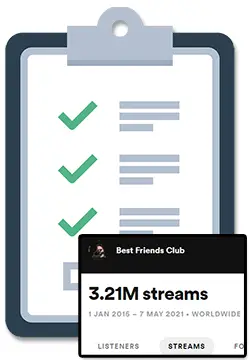I had just released a new song on Spotify, anxiously keeping track of how I was doing, until it looked like Spotify took away some my streams. I looked up the reason why and wrote about it.
Spotify can take away streams or remove music completely if Spotify believes any streams are coming from 3rd-party promo services or are coming from fraudulent accounts. They detect fake streams by looking for fraudulent accounts (ie: bots, click farms, or deactivated accounts) that have unusual listening habits and behaviors.
There are several different reasons Spotify may deem any account suspicious or fraudulent, and the way you might be gathering streams from these bad accounts is actually pretty simple to find out.
So let’s dive a bit deeper into why and how Spotify can take away your streams, as well as what you can do to get them back.
How (& Why) Spotify Can Take Away Streams
Spotify can take away your streams if they believe any of your streams are fake. But why would they do this in the first place?
As Spotify has grown more popular, evildoers have entered the scene trying to game the system by selling streams and making money off of artists by having them pay to be on fraudulent playlists.
Naturally, Spotify has had to start cracking down on this to make sure that they don’t lose money by paying out royalties for fake streams.
Here is a recap of the main sources that Spotify may see as fraudulent:
- Streams from bots
- Streams from click farms
- Streams from deactivated accounts
If your streams have gone down, disappeared, or look like they have been taken away, it is most likely that you have been getting streams from fraudulent accounts.
But how might you be getting attention from these fake accounts anyway?
The most likely way to get fake streams from fraudulent or fake accounts is by getting your song placed on fraudulent or fake playlists.
It has (unfortunately) become a common practice for scammers to sell placement on playlists with lucrative stream counts and followers. But, the catch is that these stream counts and followers are actually from bots, click farms, and/or deactivated accounts.
Ari Herstand wrote about his experience with a playlisting company called “Streamify” that got him 50,000 streams that ended up with Spotify actually removing his entire album due to fake streams.
The takeaway of that article was this: He paid to have his song placed in a playlist with a lucrative amount of followers (around 52,000 followers) where it wasn’t clear how that playlist got those followers in the first place.
So what can YOU do about this?
If you find yourself in this unfortunate situation, you have two simple options:
- Wait to see your actual streams on your Spotify royalty statement (and make sure you know how to check Spotify streams properly).
- Stop purchasing paid playlist placements (or at least start being more critical with which placements you pay for).
At the end of the day, the numbers reported in the Spotify For Artist’s dashboard are estimates and the final numbers will appear in 3 months on your actual royalty statement.
So, you can wait to see the results of your royalty statement, but waiting sucks. What can you do right now?
Luckily, your good friend Matt did a bunch of research on this topic and I have an answer for you. Plus, this info will give you a good amount of insight into Spotify’s algorithm and how you can take advantage to grow your sweet, sweet streams, baby!
5 Ways To Spot Fake Spotify Playlists Right Now
There are 5 main ways that you can spot fake Spotify playlists right now. Generally, this comes down to researching both the company and the playlist you are looking to get on.
Here are 5 signs that the playlist you are looking at might be fake:
- If the playlist company is claiming an exact amount of streams for an exact amount of money. The only real way they can guarantee a specific number of streams is if they are running a fake playlist.
- If the playlist company doesn’t share any info on the playlist they are adding you to. If you can’t check out the playlist for yourself, that can be a red flag since you can’t inspect the quality of the playlist.
- If the playlist company does not make it clear how they grew their playlist followers. If it sounds too good to be true, and they don’t give any real details, then it is definitely is too good to be true.
- If the playlist company doesn’t care what your music sounds like. If they don’t ask to hear your song or for any details like genre and vibe, they must be sticking you on a playlist that isn’t relevant just to make money off you.
- If the playlist does not have a good stream-to-listener ratio. If each song has just about exactly the amount of streams that the playlist has followers, that is a major red flag (more on this below).
As you can see, the main takeaway here is to do your research on a playlist and the company you are going to be working with before jumping the gun.
How To Research A Playlist For Fake Streams
One big way that Spotify (and you) can identify that a specific playlist is fake is by looking at the stream-to-listener ratio for that playlist. So what exactly is a stream-to-listener ratio you might ask?
A stream-to-listener ratio indicates the average amount of times the average listener listens to a song. This is calculated by dividing the number of streams by the listener count for that playlist.
For example, a real playlist will have more streams than listeners on your song as most real people tend to stream a song more than once.
If Spotify notices that listeners on a playlist are only listening to a song once, this could be an indicator for Spotify (and you) that the streams on this playlist are fake.
Where do the fake streams come from anyway?
These fake streams are often achieved by click farms (or in this case stream farms hehe). A click farm is where a bunch of phones, computers and/or tablets are set up with Spotify and either humans or automated scripts constantly play music in order to boost stream counts.
Click farms are generally based in third-world countries like Thailand or the Philippines, but it is possible for the locations of these fake streams to be faked using VPNs that change the location of the stream’s IP address.
So make sure you know what the difference is between streams and listeners on Spotify! Knowing this can be super helpful in making sure your release is on the right track.
What To Do If Your Spotify Streams Are Taken Away
The first thing you should do when you suspect Spotify may have taken away your streams is to find out if Spotify has taken away your streams or if your Spotify stats are just in the middle of updating.
Spotify updates it’s stream counts only once per day at 3 PM EST. Leading up to this time, there may be a temporary bug in the system that sets counts to 0. This is completely normal and temporary!
When your Spotify stream count has not updated in a few days, the general advice would be to simply wait it out. From time to time, Spotify stream counts may get delayed by an extra day. However, it is important to remember that these delays really don’t happen that often.
Here are some steps you can take when your Spotify stream count has not updated in days:
- Use the Spotify For Artists dashboard. The dashboard for artists that Spotify created is the most accurate and quickly updated place to check on your stream counts.
If you are using a distributors dashboard (like Distrokid for example), then get your tail over to the actual Spotify dashboard and get your stream counts from the horse’s mouth. - Make sure you haven’t been doing anything sketch. I mentioned this before but, if you have been doing some sketchy things to boost your Spotify streams (like paying for bots or click farms or getting your song on playlists that do shady things like that), then Spotify may be taking longer to dig into your data to sort things out.
- Reach out to Spotify support. You can always try to contact Spotify support for clarification but they will most likely tell you to simply wait. But hey, it doesn’t hurt to ask!
Related Questions
How does Spotify detect fake streams?
Great question! Spotify detects fake streams by looking at the data and listening habits of the streaming account. This includes where the account is located, where the account is streaming from, how many repeat listens the account makes, and where the account listens to music.
Do Spotify streams count on mute?
Another great question! Spotify does not count streams that are on mute. While streaming, do not put the song on mute, or else it will not count towards streaming counts. Seems obvious but now at least you know for sure!
Does Spotify count streams on repeat in 2020?
Another great question! In 2020, Spotify counts 1 stream when the song has been listened to for 30 seconds or more, regardless of what song was played before. If you listen to a song for 30 seconds and then listen to it again for 30 seconds, that will be counted as 2 streams.



